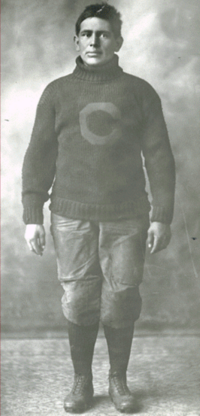Peter Hauser (American football) facts for kids
 |
|
| Carlisle Indians | |
|---|---|
| Position | Fullback |
| Personal information | |
| Born: | June 10, 1887 Fort Reno, Oklahoma Territory |
| Died: | July 21, 1935 |
| Career history | |
| College |
|
| Career highlights and awards | |
|
Consensus All-American (1907)
|
|
Herman Peter Hauser (born June 10, 1887 – died July 21, 1935) was an amazing Native American football player from the United States. He played for the Haskell Indians team from 1904 to 1905. Later, he joined the famous Carlisle Indians football team from 1906 to 1910. Peter Hauser was chosen as one of the best fullbacks in the country in 1907.
He was a very talented player who could run with the ball, kick field goals, and return punts. He is also famous for being the first player in American football to throw a spiral pass!
Contents
Peter Hauser's Early Life
Peter Hauser was born on June 10, 1887, near Fort Reno in what is now central Oklahoma. His family was Cheyenne. Records show he lived with his mother and siblings in Oklahoma Territory when he was young.
Around 1900, Peter and his brother Emil were living at a special home for orphans in Kansas. They were listed as having a German father and a Native American mother.
Peter Hauser's Football Career
Playing for Haskell Institute
In 1904, Peter Hauser became a student at the Haskell Institute. This was a boarding school for Native American children. He played football for the Haskell Indians team for two years.
In November 1904, Peter played in an exhibition game at the St. Louis World's Fair. About 12,000 people watched the game! Peter, playing as a right end, scored Haskell's only points with a field goal.
Becoming a Star at Carlisle
In 1906, Peter moved to the Carlisle Indian Industrial School in Pennsylvania. There, he played for the Carlisle Indians football team. His coach was the legendary Glenn Scobey Warner.
Peter Hauser became a huge star during the 1907 football season. In one game, he scored a touchdown and kicked a field goal to help Carlisle beat Villanova 10–0. Later, he scored eight points against Syracuse University, helping Carlisle win 14–6.
The New York Times newspaper wrote that Peter was great at kicking and returning punts. They also said he was the "mainstay of the defense." In November 1907, Carlisle beat the Harvard football team, which was one of the best teams in the country. Peter's runs were described as "marvels," meaning he was incredibly good at running around Harvard's defenders.
The 1907 season ended with a big win against Amos Alonzo Stagg's Chicago team. Peter was called a "one-man wrecking crew" in that game. He kicked two field goals, an extra point, and even threw a 50-yard touchdown pass!
The First Spiral Pass
Peter Hauser's most famous moment happened on October 27, 1907. Carlisle played against the Penn team, who were considered national champions that year. But Carlisle beat them 26–6!
Back then, most forward passes were short tosses. But Peter Hauser threw a pass 40 yards, hitting his teammate perfectly while he was running. This was a huge deal! One writer called it one of the most important moments in football history. They even compared it to the Wright brothers' first flight!
The secret to Peter's amazing throw was the spiral. Throwing the ball in a spiral made it travel much farther and more accurately. Coach Pop Warner said that Peter Hauser was the first football player to throw a spiral pass. He could "hit his ends on the dead run with uncanny accuracy."
All-American Honors
After the 1907 season, Peter Hauser was chosen as one of the best fullbacks in college football. This honor is called "All-American." He was one of the first Carlisle players to receive this award.
Coach Warner even said that Peter Hauser was "practically a replica of Jim Thorpe," who was another legendary Carlisle player. This shows how highly Peter was regarded!
Peter Hauser's Later Life
After his football career, Peter Hauser returned to El Reno, Oklahoma. This town was near where he was born. He passed away in 1935 in an automobile accident.
In 1987, Peter Hauser was honored by being added to the American Indian Athletic Hall of Fame.

